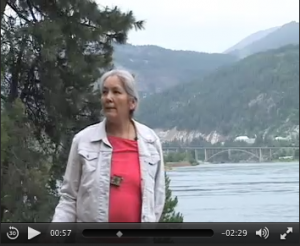Teacher Note: Depending on the length of class time available, this lesson may take 2-3 sessions to complete.
Learning Outcome
Students will describe factors that affect productivity and species distribution in aquatic environments.
Steps to the Lesson
- Discuss key vocabulary.
- Watch a video on how human activity and government policy has impacted a river system in British Columbia.
- Complete a Graphic Organizer while viewing the video.
- Conduct an investigation on how to save endangered rivers in British Columbia.
- Reflect on the process.
CONNECT
Goals:
- Students will analyze how federal policies and human activity have affected aquatic systems in British Columbia.
- Students will identify and analyze alternatives to issues affecting endangered rivers in British Columbia.
Task:
Students will conduct an investigation on endangered rivers in British Columbia and write proposals for alternative solutions on how to save the respective rivers.
Activate Prior Knowledge:
Students complete a mind map activity entitled ‘The Many Ways People Use Water’ found in the McGraw-Hill Ryerson textbook BC Science 8 (page 359). While completing the activity, students should focus specifically on what human activities impact river and lake systems.
Predict and Question:
In Canada, there is a plentiful supply of water and we rarely pay attention to how much water we use in our daily lives or how our actions impact local aquatic areas like rivers and lakes.
What are the students wondering about how human activity has impacted their local rivers, lakes and oceans?
PROCESS
Video Guidelines:
Before viewing the video, students need to understand the meaning of the following terms.
Key vocabulary to discuss: anadromous, confluence, extinction, fathom, mitigate, resident (Definitions)
Students watch the following video and track their thinking using the Graphic Organizer. Students should try to identify some key effects and implications of federal policy on the Sinixt Nation.
Reminder: It is important to stop throughout the story and give students (A/B partners) opportunity to talk or respond to the story.
Having viewed the video above, students need to share their ideas from the video Graphic Organizer (A/B partner recommended). Teachers ask student pairs to share their main ideas and generate a list of ideas and evidence on the board or overhead. Teachers lead class discussion on the significance of the ideas generated (and those not generated) and how federal policies have impacted the environment and Aboriginal people on the Columbia River system.
TRANSFORM
Now that students have learned how federal policies and human activity have impacted a regional river system (Columbia River), students will now conduct an investigation on how to save other endangered rivers in British Columbia. Working in A-B partners or groups of four, students conduct an investigation activity found in the McGraw-Hill Ryerson textbook BC Science 8 (pages 444-445). Using the chart provided on page 445 in the textbook, students will choose a local river (or river of their choice) to research and write a proposal to save an endangered river. Student groups report out their proposals to the class in the form of an oral presentation, using either poster boards, written reports, or Powerpoint presentations.
REFLECT
Upon completion of the investigation activity, students complete a Reflection Sheet to reflect on what they liked/disliked about the investigation process and how their thinking towards how Canadian Federal Government policy impacts the environment and Aboriginal people has changed.
Extend learning or next lesson
One of the key ideas from the video is the impact that Canadian federal government policies have had on an Aboriginal population in British Columbia (Sinixt nation). There are many other examples of how government policies have affected the environment and populations in Canada. Some of these include:
- Governments adopting (or not adopting) Kyoto Protocol emission targets.
- The Canadian federal government imposing a moratorium on seabed oil and gas exploration off the coast of British Columbia.
- The Canadian federal government policies regarding pollution standards in the Alberta northern Oil Tar Sands.
- The Kashechewan Reserve water crisis in Northern Ontario.
Students can complete a research report on these and other issues affecting the environment and Aboriginal populations in Canada.

